
E-mail: font@focusonnature.com
Phone: Toll-free in USA 1-888-721-3555
or 302/529-1876
 |
PO
Box 9021, Wilmington, DE 19809, USA E-mail: font@focusonnature.com Phone: Toll-free in USA 1-888-721-3555 or 302/529-1876 |
Highlights
from previouS
FOCUS ON NATURE TOURS
in SPAIN
and the CANARY ISLANDS
The
following summaries are with the most-recent tours first.
For some tours there may be links below for longer narratives. There are below
links to UPCOMING TOUR ITINERARIES, and to lists of BIRDS, MAMMALS, and OTHER
NATURE.
Some Previous
Tours:
June 2009 (SPAIN: Extremadura, Gredos Mtns, Ebro
Delta)
June 2009 (the CANARY ISLANDS)
April
2007 September/October 2005
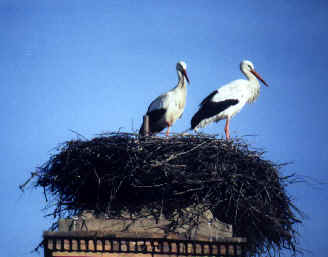
Links:
Upcoming
FONT Birding & Nature Tours in Spain & the Canary Islands
Birds & Other Nature during FONT Tours in Spain & the Canary Islands
A List & Photo Gallery of European Birds, in 2 parts:
Part #1: Grouse to
Puffins Part #2: Sandgrouse to
Buntings
Mammals of Europe (with some photos)
Butterflies and Moths of Europe, including those in Spain (with some photos)
![]()
SPAIN
- June 2009 (including
Extremadura, the Gredos Mountains, and the Ebro Delta)
During this, the
25th FONT birding & nature tour in Spain,
and our 52nd tour in Europe, we visited some wonderful places, where we saw some
fine birds and animals.
As many as 215 species of birds were found during the FONT Spain Tours in June
2009. 28 of those species were only during the extension tour in the Canary
Islands (a part of Spain) in the Atlantic Ocean. And
thus, 187 species of birds were found during our nearly 2-week tour in mainland
Spain.
Outstanding among a nice number of mammals was a particularly nice large male
Red Deer, and some Spanish Ibex high on rock cliffs above us in the
mountains.
Regions that we visited were mostly in central Spain, from Extremadura
(near the Portuguese border) to the Ebro Delta
(along the Mediterranean coast in Catalunya).
In between, places included the Gredos Mountains
and the wetland known as Las Tablas de Daimiel in
Castilla-La Mancha.
Birds that we found ranged from as big as the Great Bustard to as small
as the Little Bittern and Little Grebe, and smaller yet, to the Goldcrest
(the littlest of European birds).
Among our larger birds, some were exceptionally notable, including the Cinereous
Vulture, a rare bird with the largest wingspan of all European raptors (we
saw over 20 during 1 afternoon!), the Spanish Imperial Eagle, the Eagle
Owl (the largest European owl), and both Black Storks
and White Storks (we saw thousands of the latter).
Among the colorful birds that we were treated to there were these: European
Bee-eater (we saw many), European Roller, Common Kingfisher,
and the Eurasian Golden Oriole. Not with coloring as bright, but
certainly a bird great to see, each time that we saw it, was the Eurasian
Hoopoe.
Notable among the waterbirds that we saw were White-headed Duck (a
couple dozen), and 3 species of Gulls, among others: the rare Audouin's,
the attractive Slender-billed, and a very nice Mediterranean in
full breeding plumage.
Always nice, either by castles, churches, city walls, and other old stone
structures were the fore-mentioned White Storks, along with flying Lesser
Kestrels, Common Swifts, Western Jackdaws, and Eurasian Crag Martins.
Such birds and settings are truly the essence of
Spain.
Link:
List of Birds & Other Wildlife during our Spain Tour - June 2009
This tour, in the
fascinating Canary Islands, in the Atlantic
Ocean, off the northwest coast of Africa, followed our June
2009 tour in Spain. Although closer to Africa than Europe, the Canary
Islands are actually part of Spain.
We visited 3 of the islands, each quite different than the others. Each has its
own character.
And on each we saw birds not found on the others.
The 3 islands, during the tour, were:
Lanzarote, truly fascinating, with the most
remnants of volcanic activity, and mostly arid. At the north end of that island,
we visited an area of tremendous cliffs by the sea, where seabirds nest
and where the Eleonora's Falcon flies.
Fuerteventura, the closest of the Canary
Islands to Africa, and where the terrain and some birds are those of that
continent. Among those "African birds", the Cream-colored Courser
was a favorite of ours. We had close looks at 2 adults and 2 of their
nearly-grown young.
Tenerife, further west, and an island much
more green, with coastline (of course), and forests, fields, hills, and a
mountain as high as about 12,000 feet above sea-level. While the island is more
"green", a favorite bird of ours on this island was "blue" -
the beautiful blue of the endemic Blue Chaffinch.
During this tour in the Canaries, we saw all of the 2-dozen plus endemic and
specialty birds that we sought, including such "goodies" as the Houbara
Bustard, the Barbary Falcon, the rare & localized Canary
Islands Bush Chat, and, yes, the Canary (the wild Canary
indigenous to the Canaries).
Mammals, during the tour, included the Algerian Hedgehog and the Canary
Shrew.
Links:
More about the FONT
Canary Islands Tour in June 2009
List of Birds & Other Nature during the FONT tour in the Canary Islands - June 2009
Cumulative Lists of Birds & Other Wildlife of the Canary Islands
Cumulative Lists of Birds & Other Wildlife during FONT Tours in Spain & the Canary Islands
Upcoming FONT Birding & Nature Tours in Europe
![]()
This tour was in
southern and central Spain. It was the 24th FONT tour in that country, where it
was springtime with the birding good indeed. In fields there were symphonies of
larks. At those where we were with Great and Little Bustards,
there were songs and displays of Calandra and Short-toed Larks. Crested
Larks seemed to be everywhere. In mountains where Bluethroats were
also singing on the tops of bushes, Skylarks were displaying with their
seemingly never-ending song high in the sky. In southern Spain, waterbirds in
and near the renowned Coto Donana Reserve included flocks of Flamingos,
some rare White-headed Ducks, and the Red-knobbed Coot, a bird
more often seen in Africa. Throughout the tour, we saw raptors, including
Old World Vultures (Griffon, Eurasian Black, and Egyptian),
Eagles (Short-toed, Booted, and Golden), and Kestrels (both
Lesser and Common), just to name some. At one particular cliff,
late one day, we saw nicely an adult Eagle Owl, and nearby two fluffy
offspring. Again, the birding in Spain in the springtime, during April '07, was
good indeed.
Link:
List of Birds during the FONT Spain Tour - April 2007
![]()
Spain has been, for years, one of our favorite FONT destinations. As we travel throughout the country, there's so much to experience. In addition to the nature, and the birds (of which there are many, the most to be seen in Europe), there's also the culture, the history, and the cuisine. And there's the varied topography, as well, with mountains, rolling plains, desert, and even, along the Mediterranean coast, a delta with rice paddies. Our September/October '05 Tour was the 23rd FONT tour in Spain. Each tour there, during the past 15 years, has been a good experience. In the narrative relating to our '05 tour, that follows, we'll allude to the aspects of the culture, history, and cuisine, but the emphasis will be on the nature and the birds.
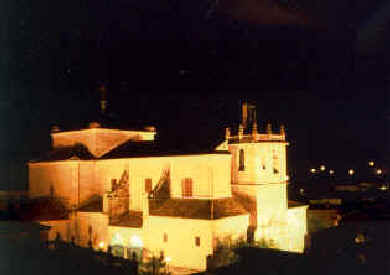
The castle in Oropesa at
night
Our first night in Spain was
spent in a castle, in Oropesa, a town atop a
hill in the Castilla-La Mancha region west of Madrid. We often reside in that
castle (now a parador) our first night. Also residing there in either the
holes in the stone walls, or on the roofs and towers of the castle and other
buildings nearby, are many birds, especially during the warmer months. These
birds include Jackdaws, Lesser Kestrels, White Storks, Common Swifts, Crag
Martins, and Barn Owl.
As we had our first breakfast of the tour (a wonderful one at the parador), with
an assortment of hams, cheeses, fruits, and the regional specialty known as
"churros", outside the window, some Black Storks flew by. Black
Storks are not as common in Spain as White Storks. Both are migratory,
with most heading south to Africa for the winter. That sighting of the storks
outside the breakfast window was fortuitous. They were the only Black Storks
to be seen during the tour. Most of the Spanish storks (both Black &
White) had already, in late September, departed. So, it was,
for us that morning, a good beginning.
From Oropesa, we continued further west, into the vast, open region of Extremadura.
That word in Spanish connotates "extreme, outlying, furthest out". In
that area, and in nearby Portugal, we got the feel for that distinctive region,
of rolling hills with oak and cork trees. It's a region without many people.
Over the years, it's been a region that people have left. When the Spaniards
went as explorers to the Americas, most of those whose names we know from the
history books, came from Extremadura. Many came from the one city in the region,
Caceres. We had a fine dinner there one evening. But in most of Extremadura,
there are either small villages with few people (we spent 2 nights in one), or
areas with no people at all. In those areas, there are, however, birds,
and notably some "good birds" that we saw and enjoyed. Among them were
the rare Spanish Imperial Eagle, and the also-rare Eurasian Black
Vulture. The latter is also known now as either the Monk or the Cinereous
Vulture. Whatever it's called, it's rare. It's also the largest flying bird
in Europe.
Rare many places in Europe, but not in Spain, is the Griffon Vulture. We
went to top of a ridge, near where we stayed in Extremadura, and watched Griffons,
nearly eye to eye, as they floated in the sky by us.
One morning we went, early, to a place with big open fields of grain. We
traveled, in our vehicle mostly on tracks. Our objective was to see big and shy birds
known as bustards. We did. We saw some Great Bustards, standing
and in flight, and we saw a Little Bustard. Great Bustards are
bigger than geese, and appear a bit overweight (even though they eat the
grain of the field, and not the "churros", the breakfast item
mentioned earlier that are rather like fried donuts). Little Bustards,
although called "Little", are really not small birds. Our experience
with the Little Bustard that morning was quite fun. After we spotted it,
standing on a dirt field, it walked to the one stringy bush around (actually
but a twig), and stood motionless behind it, "thinking" that it
was invisible to us. In our vehicle, however, we were having a wonderful look.
Nearby, on a small pile of rocks, another bird was looking at us (or at least at
our vehicle). It was a Little Owl. Again, that's a bird that's relatively
"little". Another Spanish owl, the Scops Owl, is smaller.
One evening in Extremadura, conversely, we had our encounter with the largest of
the Spanish owls, in fact the largest of the European owls. An Eagle Owl
was on a cliff-side, on the other side of a river. At twilight, it called
continuously.
Extremadura is an area that's often quite hot in the summer. And that part of
Spain is often quite dry. The "rain in Spain" doesn't mainly fall
"on that plain". During the summer, prior to our tour, the area was
even drier than usual, with quite a drought. So, as we traveled about, places
with water, such as ponds and streams, were those with the most birds. But, the
particular place that was actually the best for us in that regard was one with
just a drip. It was a spring. A few people would come, on occasion, to fill up
their bottles. But, otherwise, it was a place for us to sit quietly and watch
the procession of birds that would come to drink. There were Blue Tits
and Robins (both dapper little birds), Blackbirds (actually
thrushes, like all-black American Robins), but the best were
the warblers. We had good looks at Sardinian, Subalpine, and Melodious
Warblers, and another called the Blackcap, as they all came in to the
dripping water from the spring.
As much as we enjoyed watching those warblers, probably the bird that we enjoyed
the most during the tour was the Hoopoe. Every one was fun.
A part of Spain that one can not help but like is the region of the Gredos
Mountains. It' a great place to walk, up high in the hills. Above the
treeline, where we saw the animal known as the Ibex, the birds included Linnets
and Pipits. There were also wheatears and wagtails. Further
down the road, along a stream, one of our nicest encounters was with a Dipper.
The European Dipper is not gray as is the American. Rather, it has a
white throat, and a brown back and belly.
Overhead, in the Gredos, we looked up at some fine raptors. Buzzards (buteos,
somewhat analogous with Red-tailed Hawks in North America) were joined one
morning with a soaring adult Golden Eagle (nice, on whatever continent
it is seen), and some beautiful Red Kites (raptors, anywhere,
don't get much better). Some Hobbies flew about over the pines. In
the pines, there were Crossbills. Again, one can not help but like the
Gredos.
As we traveled throughout Spain in late-September and early-October, there was
an apparent bird migration. In the Gredos, there were flocks of Mistle
Thrushes. Throughout Spain, there were Pied Flycatchers and
warblers called Chiffchaffs. Along the Mediterranean coast, in the
area of the Ebro Delta, shorebirds
were on their way south. We saw, among others, Little Stints, Curlew
Sandpiper, Ruffs and Reeves, Greenshanks, 2 species of Redshanks
(the Common and the Spotted), 2 species of Godwits
(Bar-tailed and Black-tailed), and Whimbrels and Curlews.
Not bad things to see.
But the favorite at the Ebro
were the flocks of flamingos. Those partly pale, and partly bright pink
birds, were great to see either walking in the lagoons, or flying in the sky
above. Also favorites were two birds with the adjective Purple: the Purple
Heron and the Purple Swamphen. Two of the gulls of the area
were also notable, the rare Audouin's and the distinctive Slender-billed.
In all, 9 species of gulls were seen there. The others were: Black-headed,
Mediterranean, Little, Herring, Yellow-legged, Lesser Black-backed, and Great
Black-backed.
Among the ducks there were Red-crested Pochards. Other birds the marshes
and lagoons included patrolling Marsh Harriers, striking Pied Avocets,
and the little bright turquoise jewel known as the Kingfisher.
The Ebro Delta, as you can tell here, has water. A place further inland that
doesn't (or doesn't have much) is an apparently barren region known as
the "Spanish Steppes". But there
are birds there too, including a rather special "shorebird"
that favors such an area. We were treated, there, to a good, close look at a
flock of Eurasian Dotterels. Also on that high, windy plateau were Red-billed
Choughs and a large flock of Calandra Larks. Such birds can make a
place seem not barren at all.
Our last place in Spain to mention here is referred to primarily because of the
place itself. It's called Albarracin, and
it's a town in the region of Aragon, that's spectacular in terms of its setting
and its character. Located in a natural amphitheater, with high cliffs on 3
sides above a winding river, the town is actually perched on the sides of the
cliffs. Renowned for its "hanging houses", it was once a Roman town,
well protected by the features of the land. Later, it was, during the Moorish
occupation in the 11th Century that the town gained more significance. Today, as
one looks out from the balcony of the hotel, or from the plaza, the history is
in evidence. Still today, in the town, most of the streets are too narrow and
steep for cars. There are elaborate iron window gratings and door knockers and
handles that are the shapes of lizards and serpents. Houses are simple but often
multipurpose, for example, for the sheltering of animals, and the storing of
wine. Near the town, there are caves in which there are "prehistoric"
drawings.
As noted earlier, Spain is not only place for nature and birds (as it good as
it is), but also one for history, culture, and cuisine. Again, as during our
previous tours, Spain in '05 was a good place to be, and we look forward, in the
future, to touring there again.
Something that won't happen for us again during a future tour in Spain, did
happen during the last day of our '05 tour, on October 3rd. In an absolutely
clear sky over Madrid, in the late morning, there was an Annular Solar
Eclipse. We watched (through protective glasses) as the form of the
Moon, smaller than the Sun, passed in front of it, creating a "ring
of fire" that lasted for 4 minutes and 11 seconds. It was the first
such annular eclipse in the Iberian peninsula since April 1, 1764. The next one
there won't be until the year 2028. The eclipse that we were fortunate to
experience in October 2005 was certainly great to see, and especially as well as
we did.
![]()
Spain,
Lammergeier, Wallcreeper, & a Hedgehog,
June-July 2003
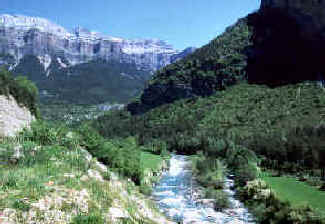
The
Pyrenees Mountains in Spain
are
spectacular, with alpine terrain and topography that's unsurpassed. Two of the
species of birds that occur there can also be said to be spectacular the Lammergeier
and the Wallcreeper.
During our just-completed FONT birding tour in that region of Spain we saw both.
Both are birds of remote, wild, and of inaccessible, high country, favoring cliffs, crags, precipices, canyons and gorges.
The Lammergeier is a large bird,
also known as the Bearded Vulture. It's body is nearly 4 feet long. Its
wings about 8 and a half feet across. On the bird we saw, as it flew against a
sheer, rocky cliff-face, its orange-buff body, black wings, long tail, and black
facial mask could readily be seen. As always, seeing a Lammergeier in flight is
a thrill.
No where is it a common bird. Its range, even though large, across Eurasia and
in parts of Africa, is scattered. Lammergeiers have large territories. In the
Pyrenees, it's said that 2 pairs can have an immense home range of 100 square
kilometers.
Wallcreepers
share with the Lammergeiers the habitat of large rock faces, and the range
across Eurasia (not Africa), throughout which it too is never common. But the
Wallcreeper is not 8 feet by 4. Rather, it's only 5 inches.
Related to nuthatches, the Wallcreeper flits with a jerky gait on rockfaces.
Unlike a treecreeper, it does not use its tail for support.
The bird's a bit like a gray moth (but with burgundy butterfly wings). It flicks
those wings constantly. That behavior is adapted by juveniles as soon as they
fledge. But they are even a more uniform light-gray against rocks often much the
same coloration. We went to a place, truly beautiful in the mountains, where
Wallcreepers had just nested. With some patience, and good fortune, we saw what
was apparently one of the young birds flitting against the rocky cliff above us.
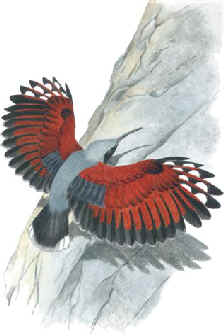
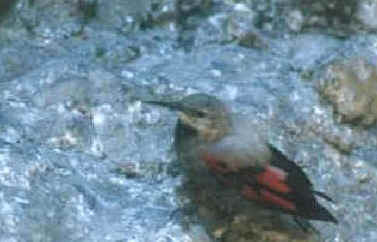
As we were lying still on the ground and looking up, waiting for the small bird to reappear, move cross the rock, and then disappear, we became ourselves items of interest for large birds circling overhead. Massive Griffon Vultures came closer and closer (until we moved). Conversely, small birds that visited us as we waited were Firecrests and Crested Tits. Choughs were acrobatically flying about. Nearby, a pair tended to a young bird in a crevice. The Choughs were vocal as they flew, as were the Ravens flying higher above us.
At another time, in the Pyrenees, we crossed into
France. There, from a high road, we were actually able to look down upon a nice bird, a Honey-Buzzard floating in a circle beneath us. A Red-backed Shrike perched nearby. As we went back, over a pass, across the border into Spain, in addition to various birds, we had nice looks at an alpine animal, a goat-antelope, that's been known as the Chamois. Recently, Pyrenean Chamois (along with those Cantabrican and Alpennine) have been ascribed to a separate species Rupicapra pyrenaica, the Apennine Chamoise or Isard.Regarding change however, and giving credit to adaptation, in the past on the Spanish side of the Pyrenees, the currency was the Peseta. On the French side, it was the Franc. Now, on both sides, it's the Euro.
Also in the Pyrenees, we birded by structures (monasteries and the like) from as far back as the 9th Century - pre-peseta.
A site south of the Pyrenees that we visited was a town (known as Belchite) that was destroyed during the Spanish Civil War (in the 1930's). As a way of commemorating how bad war can be, only the rubble of buildings is there now. No people anymore. But by the destroyed church, there are resident Black Wheatears and Blue Rock Thrushes, along with the more-common riffraff of House Sparrows. In Belchite today, birds live (and probably other creatures). But not humans.
Not far away, in an area of desert called the
"Spanish Steppes", there were other birds for us to see. There was another wheatear (the Black-eared Wheatear, say that fast), and larks (some with greater short toes and some with lesser short toes, yes, to put it otherwise, both Greater Short-toed Lark and Lesser Short-toed Lark). Where also Crested, Thekla, Calandra, and Dupont's Larks reside, in a "land of larks".The
Ebro Delta by the Mediterranean Sea is far from dry. It's a vast area, with fields of rice, thus lots of water. And lots of birds. Obvious among them were herons and egrets Grey, Purple, and Squacco Herons, Little and Cattle Egrets. And Little Bittern (always nice to see). Ducks included the Red-crested Pochard. Great Crested Grebes, Moorhens, and Coots were also in the mix.The delta juts miles into the sea, with a large amount of habitat favored by shorebirds. Those we saw included both Common and Spotted Redshanks, both Curlew and Whimbrel, both Black-tailed and Bar-tailed Godwits, Plovers mostly Kentish but also Ringed and Grey (or Black-bellied), Eurasian Oystercatcher, Pied Avocet (with young), and Black-winged Stilt.
Greater Flamingos waded in pools where also there were some notable gulls, including the rare Audouin's, Slender-billed (often with the flamingos), Mediterranean, Black-headed, Lesser Black-backed, and Yellow-legged (the last of these the most common along the beach).
As interesting as the gulls were, the terns were more so. Along the coast, in an area of a huge spit of sand, there were more terns than one could be imagine. Thousands of terns were flying over the surf, all in the same direction (toward their nesting colony). Each and every one of the terns had a small fish in its bill. Yes, there were thousands. Most were Common Terns (if ever that term for a tern were appropriate it was there). Also in numbers were Sandwich and Little Terns. And Gull-billed Terns, which wandered away from the sea inland to fields to catch insects, and Whiskered Terns. Above some rice fields there were swarms of Whiskered Terns. How nice it was to be in area where terns were so abundant!
During our last evening in the delta, we visited a place with shallows pools near the mouth of the river. More birds were added to our list. Particularly nice were Collared Pratincoles flying about, and Purple Swamphens with young. Unusual for Spain were 4 Great Egrets and some Glossy Ibis. Out of season was an Arctic Loon, or Black-throated Diver, flying over the sea by the rivermouth. You never really know what you're going to see during a birding outing in the Ebro Delta.
We then headed back, that evening, toward
our hotel. To the west, there was ahead of us a most beautiful pink and blue sky
just after sunset, with coastal mountains making a fine backdrop. We were
traveling along a road, quite narrow, in an area of fields. And then, ahead of
us, something rather odd-looking was moving across the road. It was a Hedgehog.
Not at all a hog or pig of any kind, actually a creature about a foot-long
covered with spines. And not related to Porcupines either. It's completely
different. Actually the Hedgehog is an Insectivores, most closely related to
smaller Shrews and Moles.
We stopped the vehicle, backed-up, and got out. The animal was still on the road, but oddly, it had taken the shape of a BALL. Hedgehogs do that. They "curl". When danger's perceived, it's done because of an interesting ability. The Hedgehog has a larger skin, beneath which there is powerful muscle covering the back. The large skin is more strongly developed around the edges than at the center. It's only loosely connected to the body underneath. When it contracts, like a drawstring around the opening of a bag, the contents (that is most of the animal) is forced into the "bag" as the string is drawn tighter. When a hedgehog thus "curls", two muscles pull the skin just referred to over the head and rump. So, the BALL takes form.
The most distinctive feature of the Hedgehog is its spines. An average adult has about 5,000 of them, each about an inch long, and with a needle-sharp point. When the animal "curls", the skin with spines covers everything (including the otherwise unprotected underparts). Muscles that automatically stretch erect the spines, and so the tighter a Hedgehog curls, the spinier it becomes.
With a stick, we pushed the rolled-up ball of a Hedgehog off the road. It softly hissed. The animal's protection that's evolved over the ages would have been no protection at all if another vehicle would have come along that narrow road.
Our encounter with the Hedgehog was just one of the enjoyable aspects of our 2003 tours in Spain. Nearly 200 species of birds were seen. There's a complete complete listing of birds found during FONT Spain tours in this web-site.
![]()
Spain
Imperial Eagles & other raptors, Eagle Owl, Great Bustard, & more
June 2003
The following account written by Armas Hill, leader of the tour.
This was our 21st FONT birding tour in
Spain, since our first there in 1991.Certainly the best birding highlight of
all was when 4 Spanish Imperial Eagles appeared together in the sky above
us, as we were traveling along an Extremadura country road.
The Spanish Imperial Eagle is one of the rarest birds in the world. The
current population estimate is just over 100 pairs in total. The 4 eagles that
we saw in the sky above us were close. They circled, and flew about in various
directions, again, and again, interacting with each other, and vocalizing as
they did so. Two of the eagles were adults. Two were immatures. Apparently it
was a family grouping. On the adults the notable white leading edge to the wing
and white scapular patches were seen well. The juveniles were a brown-red
coloration overall. What a nice way it was for us to see one of the world's
rarest birds. They stayed with us for about 10 minutes before drifting off.
Actually we had already seen another Spanish Imperial Eagle (at another place) earlier that day. And the species was just one of a few eagles we saw. We enjoyed nice looks at Short-toed Eagle, and Booted Eagles (both light and dark morphs).
During the morning of the same day we saw the Imperials, we also had a tremendous look at the rare Eurasian Black Vulture, not high above us, against the clear blue sky. That species, also now called the Cinereous Vulture, is the European bird with the largest wingspan, and one of the 3 or 4 biggest raptors in the world. 4 species of Old World Vultures occur in Spain, including the Black, the Griffon, the Egyptian, and the Bearded (also called the Lammergeier). Old World Vultures are quite different from New World Vultures, in both structure and behavior. Actually, it's only the word "vulture" that they have in common. Old World Vultures are birds of more remote countryside, of which there is much in Spain. There are more vultures in Spain than in any other European country.
Spain is one of the best places, not only in Europe, but anywhere, for raptors. In addition to those just mentioned (the Spanish Imperial and other Eagles, and the Cinereous and other Vultures), there are numerous Kites (including the Black and the Red), the Montagu's Harrier, and the Hobby (just to mention a few of the species that occur in the country).
Another raptor that we enjoyed as much as any, was the Lesser Kestrel. Throughout much of its range, it has declined drastically in recent years. But in parts of Spain, large numbers still occur. The species is gregarious, and is often seen hawking for insects. Just outside the window of a castle (now a place to stay, a "parador"), we watched as we ate breakfast, Lesser Kestrels closely, coming and going from cavities in the rock wall. They perched on ledges. The male in the sunlight was beautiful, but all of the dozen or more that were seen at once, were wonderful to see.
At the end of the same day, we had another nice encounter, with a "nocturnal raptor", the Eagle Owl. It's a huge owl, with 10 times the mass of a Long-eared. Looking at a large rock cliff-face, we saw an adult quickly fly, at day's end, around a rock, out of view, as it went out to hunt. Young birds were also on the cliff-face. We could hear 2 of them begging, as their loud hissing voices echoed from the rocks. Then we saw one of the nearly-grown youngsters (already big) walking around on a ledge. In our scope, it was a nice sight, as the owl acted rather like a youngster, playing with sticks. As darkness fell, and the young owls continued their begging calls, a Red-necked Nightjar flew by between us and the cliff.
We've referred to some big birds, such as eagles, the large Black Vulture, and the Eagle Owl (large even when it's young). But there was another "biggie" that we saw well during our tour. It's the heaviest of all Europe's birds, the Great Bustard. We were so fortunate to see some of them closely. 5 males walked in a single-file procession, each keeping pace with the others, moving with an apparently bustard-style motion with their heads going back-and-forth. Another Great Bustard was seen even closer, a female, walking slowly along the edge of tall grass. A short while later, 4 young Great Bustards flew by us, somewhat high in the sky. Great Bustards fly like geese with eagle-wings. In all, we saw 11 Great Bustards.
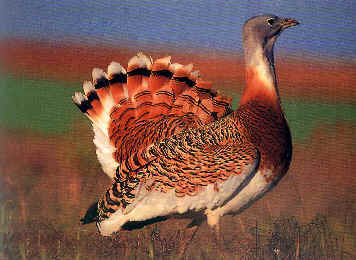
There were a number of other birds during
the tour that were wonderful to see. Among them:
A singing Bluethroat, seen well in good sunlight, in a beautiful mountain
setting.
A Black-bellied Sandgrouse on a lakeside mudflat, before taking flight
right by us.
Large numbers of White Storks at their nests on churches and other
structures.
A family of Black Storks at a nest, in a wilder place, on a riverside
cliff.
A brilliant little turquoise "jewel", called the Kingfisher.
Rollers, also with a brilliant
blue, on their wings.
Bee-eaters, colorful throughout.
Strikingly-patterned Hoopoes.
The also nicely-patterned Woodchat Shrike.
The brightly-colored Golden Oriole.
And, a namesake of Spain, the Spanish Sparrow.
Not birds, but fun to see were Spanish Ibex (over 25), walking on high rocks in the Gredos Mountains - males, females, and young.
Mentioned here have been just some of the
sightings during our 21st Spanish Birding Tour.
We plan to go to